
|   |

|   |
The fading milieu - Padma Jayaraj e-mail: padmajayaraj@gmail.com Photos courtesy the artist January 15, 2015 Sweta Chandra is a thinker artist molded by Kalabhavan, Viswabharathi University, Santiniketan. A post graduate in painting, she had stint in teaching. Now based in Hyderabad, she is a freelance artist. Her earlier works are noted for their lyrical and poetic quality. Her recent works ‘Transforming Life’ are a series that lends voice to the voiceless. ‘The Fading Milieu’ exhibited in Jahangir Art Gallery, Mumbai (24th to 30th December 2014) project the issue of the life of mute creatures in changing environs. The characters in her paintings are those who inhabit the earth on par with humans. But they are losing their habitat because of human invasion. And the artist questions the legitimacy of the human act from an ethical angle 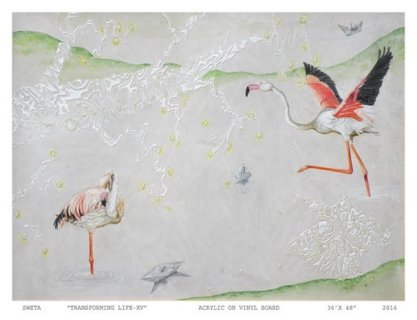

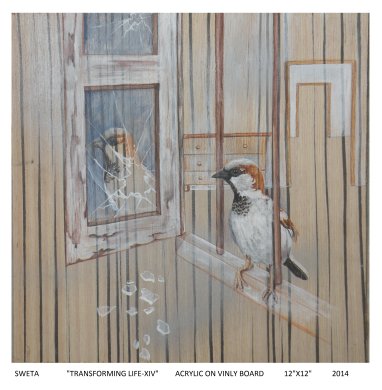
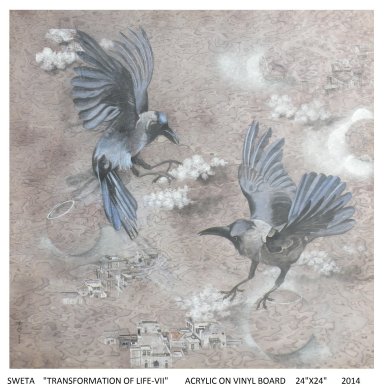
As the title of the series ‘Transforming Life’ suggests, the birds and insects try to accommodate to the changes that humans have wrought in their territory, by transforming their natural instinct. In an environment where vegetation is absent they build their nests with synthetic wires. We see the creatures of her paintings, frantically search for nooks and corners to live amidst concrete structures and glass houses. The bird at the broken window is fooled by its mirror image. Broken pieces of tingling glass fall down as tears trickling down. It reminds you of the poignant tales of medieval stories where maidens were kept in towers by cruel men with magical powers. They were saved by heroes and lovers in those times. But for the bird no savior ever comes. Caught within artificial environs they are lost beings in a desolate world. The dragonfly has come in search of honey to a plastic lotus. The early bird in search of worm is duped by cigarette butts. A wasted barren land of plastics and fiber is no consolation to the living beings whose home is earth. The artist wields her brush to fight for our feathered companions who have accompanied us in human history down the millennia. The fables told and retold down human story is part of our oral literature. Ancient characters of myths and fables reappear to create a modern version befitting to our times. The protagonists here are the inheritors of the loss. The lone crane on the banks of a dried up riverbed is not fooled by the jackal as in the fable. She is teased by a glass bubble, a discarded toy that carries the colored image of a fish within. The thirsty crows in search of water fly past a dried pot. Countless children in their nursery class have sung of the mother duck who said, ‘Quack…Quack…’ to call her ducklings that swayed past the hill. But here the mother duck is so confused to consider soft toys as her ducklings. Paper boats symbolic of life’s journey in poetry, choke the streams today. 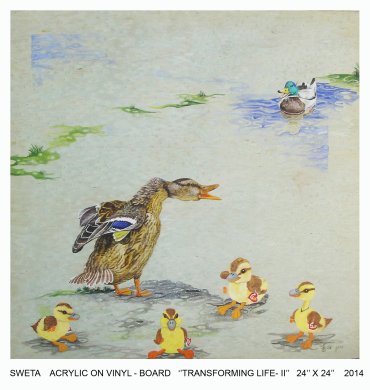
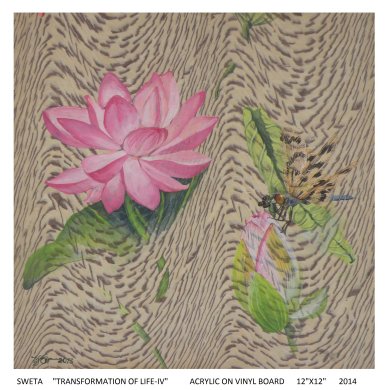


Surrealistic in tone, couched in visual thoughts the characters foregrounded against a bleak dryscape acquire symbolic significance. Romance is lost in this dreary world of stark reality. The minimal color palette is an effective tool that highlights its authenticity. Irony gains another dimension. The flora and fauna is no longer part of human world. The green hue is missing here, the green symbolic of nature that nurtures life which includes all living beings besides humans. Smothered by synthetic material we live in a make believe world. Against the lifeless backdrop in subdued hues, the images become metaphors. Poignantly cast, they evoke saddest of tales ever told since ancient times. Who is responsible for this tragedy? What can we do? Save them, save the environment, save our children from make believe world of plastics. Each painting is a cry smothering the cry of a sensitive soul. May it echo from soul to soul to sensitize the human world. Padma Jayaraj is a freelance writer on the arts and travel. She is a regular contributor to www.narthaki.com |